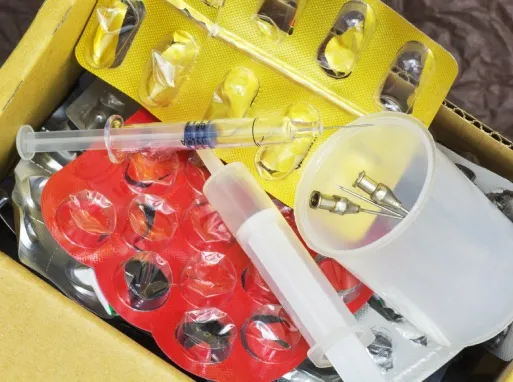What Are The Importance Of Managing Biomedical Waste?

Did you know that the products you use to clean your home could be radioactive or hazardous? Biomedical waste could be both, and can harm you in a variety of ways. “Bio-medical waste” refers to “any material that is generated during treatment, diagnosis or vaccination of human beings as well as animals”.
Biological waste bin is classified by the possibility of causing infection or injury in the process of handling and disposal. Incorrect management of waste produced in health care facilities has an immediate health risk to the people living in the area, health professionals, and the environment.
Here’s a quick guide to guide you through the vitality of biomedical waste management.
Why Is It Important To Separate Waste?
Segregation of naturalwaste is an essential aspect of any sustainable waste management plan. Each facility is able to separate their waste from the source to minimise the chance of spreading infection as well as the expense for disposal and handling.
Effective segregation ensures the hazardous materials are dealt with in a secure and environmentally sustainable manner, with no threat to healthcare workers or patients.
In each stage of the process of generating waste there should be distinct, appropriately label and colour-coded biomedical waste bins that are appropriate for the kind of waste.
When waste is send to treatment or disposal contamination of the load could impact the process of disposal. The contamination occurs when waste is place in the incorrect biological waste containers.
Biomedical Waste A Guide To The Management Of It
On average, countries with high incomes produce 0.5 kilograms of dangerous waste per bed/day in comparison to 0.2 kgs/bed per day for countries with lower incomes. This is because, often they don’t segregate the non hazardous and hazardous waste properly.
This biological waste management results in contamination of all waste. According to the Ministry of Environment and Forests nearly 28 percent of biomedical waste are not treat and is not dispose. About two-thirds of biomedical waste is treat scientifically.
According to WHO the WHO, more than 90% of the hospital waste can be classify as general waste. A further 15% of waste is biomedical waste that is hazardous and classify into Infectious and Non-Infectious Waste.
Biomedical Waste And Its Effects
The impact of biomedical wastes on the environment as well as on the health of humans is extremely harmful. Animals can take grip on materials that are contaminate by bacteria and spread the infection to people.
If someone is caught illegally disposing from medical debris in dump bacteria that are deadly could be absorb in the drinking water, and eventually infect the entire population.
Security: measures for handling biomedical waste
Personal safety equipment (PPEs) is a must for everyone who handles waste
Gloves: Rubber gloves should be used to handle waste by waste handlers. Once the garbage is handle, gloves must be remove
Masks: Waste handlers should also wear a face mask while working with the waste, particularly when they sweep
How Can We Get Rid Of Waste From Biomedical Treatment?
Health of the patients is crucial for hospitals. Which is why it is essential to get rid of waste from biomedical treatment. The proper clinical waste bins containers are an integral part of protecting patients from any illness that they may contract while in hospital.
The employees are responsible for separating and putting the waste in biomedical bins. In accordance with federal and state guidelines this is the initial step to properly dispose of biological waste.
After the waste has be divide into the appropriate biomedical waste container Waste companies are able to collect the garbage. They then transport the waste to a treatment facility where they will treat the waste before getting rid of it.
Effective Separation Of
Make sure that each trash item is collect and treat according to guidelines for each kind of waste.
- Offers recycling opportunities
- Beware of the illegal use of drugs
- Make sure that the healthcare professionals, patients and their visitors
- Stop the mixing of waste in the municipal waste stream
What Is It That Makes Biohazard Containers Securing?
If you’re a doctor, nurse, or other healthcare professional, you’re aware of the significance and purpose in biohazard storage containers.
These bins, situate in medical offices and dental offices, hospitals, clinics, treatment centers, as well as other locations are design to ensure the health and safety of all who enter your doors.
While you and your team members are aware of the importance of make use of these bins to store medical waste until it’s collect by your disposal service, however, you may not have consider what the reason they’re so secure is. Check out:
Made From Special Plastic
Biohazard containers be sturdy enough to hold a range of substances, including liquids, linens, sharps, and other items that contain clinical waste bin collection.
Since they’re made of polyethylene, which is a high-density and extremely durable plastic, biohazard containers stop the vapours, liquids and needles from entering to ensure that medical waste isn’t a threat to the health of your patients or employees.
Lids That Lock
A key safety feature in biohazard containers is that they come with locks for lids and cover. If it’s a sharps container or one use for other items that are hazardous These containers can be secure to make sure that nobody can get their fingers inside or remove items from them.
Bins Are Spill Proof
Biohazard containers are create to keep spills out and due to their tough plastic construction as well as their locking lids and covers they are virtually invincible of spills. Even if they happen to be damage or drop the lid will remain solidly in place and store medical waste in a safe place.
Reusable
While biohazard bins of the past were require to be remove after every use, modern containers are make of recyclable materials that allow reuse, which has many benefits, including saving money and being eco-friendly.
Most of the time your biohazard waste bins will be examine by the waste disposal company to ensure that they remain useful and can be utilise repeatedly. Even though you probably employ biohazard waste bins on a regular basis at your medical facility, most medical professionals don’t think about them.
Treatment And Disposal
Close the container permanently when it’s 3/4ths full or when the items don’t effortlessly drop into the container regardless of the level of fullness. (Do not try to force objects into containers or move the containers to make the container larger!)
Place empty containers in the designate biohazardous waste disposal place. If the containers are collect from an external supplier (i.e., Stericycle) the container that is close inside the waste container provide by the vendor to be pick up and dispose of.
Solid, Non-Sharps Biohazardous Waste
These include lab equipment that have come into contact with biological material. Which contain synthetic or recombinant DNA, medical specimens within the laboratory or any other lab material which are consider to be infective. Examples include:
- Gloves that are used to manipulate biological materials,
- Disposable culture flasks for serological pipettes Pipette tips, well plates,
- Objects that are contaminated with blood in a way that could pose a personal danger of exposure (i.e. more so than being incidentally contamination).
Storage
Take waste out of a leak-proof, solid-wall container that is line with an autoclavable biological hazard bag. The container must have a lid, and it should be identify with the symbol for biohazards. The container must be close when not being use.
If clinical waste collection are to be collected from an external service (i.e., Stericycle) Place the securely sealed bag in the vendor’s waste container for collection and disposal. The waste bags are then either autoclave or burn to be dispose of at the discretion of the seller.






